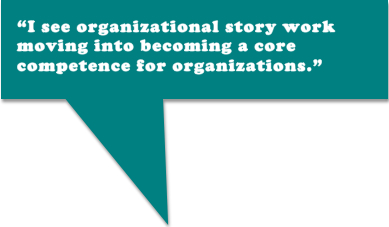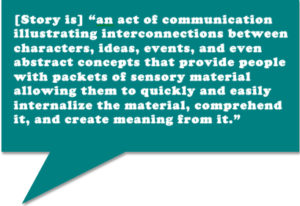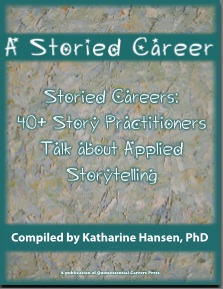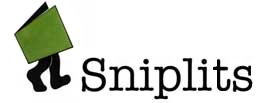

I first encountered Karen Dietz while working on my dissertation and have eagerly followed her work ever since. It is a true thrill and privilege to present her Q&A here. This Q&A will appear over the next five days.
Bio (from her Polaris Associates Web site): Karen Dietz, PhD., owner of Polaris Associates Consulting, Inc., works with leaders and executive teams who want to assemble and cultivate their most compelling stories, and tell them in ways that produces results. Her background in the diverse fields of folklore, creativity, strategy, organizational development, high performance teams, and interpersonal communication have allowed her to develop targeted approaches to executive storytelling and organizational narratives. As a coach, facilitator and storyteller, her clients have included Walt Disney Imagineering, Chase Manhattan Bank, City of Santa Monica, and Avery Dennison.
Karen draws on her experience in top-flight organizations to provide practical experience, guidance, and tools that can be put to work immediately.
Karen received her doctorate in Folklore from the University of Pennsylvania and is the former Executive Director of the National Storytelling Network. She is a member of the National Communication Association, Organizational Development Network, the National Storytelling Network, an online organizational narrative community of practice Worldwide Story Work, the past president and former program chair of the Storytelling In Organizations Special Interest Group. Karen is also a certified coach in Vocal Awareness techniques, and is one of the few in the field of stories and organizations bringing together story and vocal skills for greater effectiveness. In addition, her personality type reports for work environments are popular and sold worldwide
In her own words: “With a PhD in Folklore, I’ve always been engaged with stories. When I moved from academics into business training and consulting, I was always listening for, working with, analyzing, and retelling stories as a part of my team building, org change, and leadership engagements.
“In working with senior executives and organizational change, I repeatedly saw how if a leader could tell a compelling story about what change needed to happen, and why, the chance of the initiative succeeding was great. If they could not tell a compelling story about it, I could guarantee the initiative would fail. Why waste all that money doing a year’s worth of research, recommendations, plans and action steps when it could all go so easily down the drain in just a
few moments?
“In 2000 I decided to shift my business to working with senior executives, organizations, and their stories so they could stop wasting buckets of money. And be more effective!
“Over the decades, as a professional storyteller, I’ve been trained by some of the best performance storytellers in the nation.
“My goals for leaders are to increase their effectiveness, be compelling, capture the hearts and minds of people, and save money.
“My goals for organizations is to crystallize their identity through compelling stories, be more effective in both internal and external communication, produce bottom-line measurable results, and increase their profits.”
Q&A with Karen Dietz, Questions 1 and 2:
Q: You offer a workshop described this way: “For the past 20 years, a complete cycle of stories has been slowly dying while a new cycle of stories is rapidly growing. Understand where our culture is heading and how these changes in story impact your product/service, marketing and sales strategies.” I’m sure you could write volumes about this story cycle, but if you can summarize briefly, please tell readers the cause of this cycling of stories and a few key characteristics of the new cycle of stories.
A: I’ve changed my thoughts on this statement, somewhat. I am now focusing on the mono-myth of the hero and how inadequate it is today to meet our needs as a human race. Of course, the hero story will always be present. But today almost all of what we do has been reduced to the hero’s story or journey. Not everything we do is heroic, and there are plenty of other journeys than the hero’s. In fact, when I work with leaders, I talk about how the hero story that they’ve grown up with in an organization needs to be replaced by the magician’s story and journey. The hero’s journey is a story of an individual. The magician’s journey is the story of a community. It’s based in building community, telling and sharing stories of community in order to reach a goal. At some point, every manager has to put away the hero’s story of an individual making it happen. Instead, they need to become a leader who, as a magician, facilitates organizational change. I could write volumes on this topic, and it’s only in the last few years that I’ve started to share some of my thinking about this.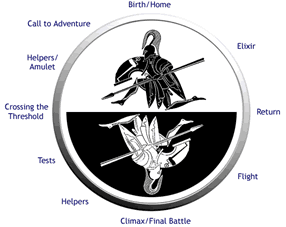
On the story cycle: Why are we so steeped in the hero’s journey? I wish I knew. Organizational story professional Richard Stone talked many years ago about the “de-storification” of our culture. You can see it all the time in the formulaic movies Hollywood produces. And you can see it when the news media scrambles to identify a lone hero when in fact the story is about several heroes or a community of heroes. Where are the trickster tales? Where are the stories of community? Where are the king or queen stories? Where are the crone stories? I could go on. So as a storyteller, I am always asking myself, “What are the stories that are not being told that people might need to hear?” and “What different kinds of stories do I need to listen for?” I find those to be much more provocative questions that helps shape my work as coach, consultant, trainer, and storyteller.
Q: How did you initially become involved with story/storytelling/narrative? What attracted you to this field? What do you love about it?
A: I initially became involved in storytelling through graduate school where I was receiving my doctorate in Folklore & Folklife from the University of Pennsylvania. I was exposed to storytelling as an academic subject, but it really made an impact on me when I got to know storyteller Ron Evans from Canada. As the keeper of the sacred stories for his tribe (Chippewa/Cree), he taught me the power of oral storytelling, and I learned the most about stories and storytelling from him. His lessons about the care and feeding of stories I still carry with me today, and I do my best to pass along what he taught me.


